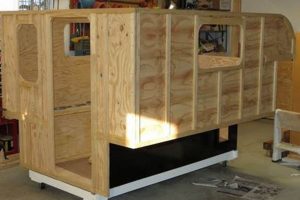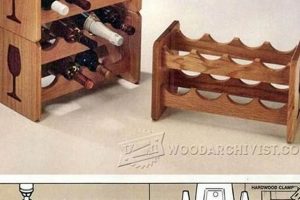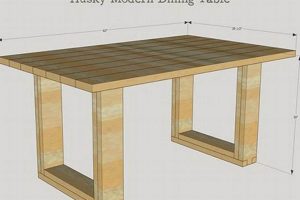Constructing radio-controlled aircraft capable of jet propulsion at home involves designing, building, and piloting miniature flying machines powered by electric ducted fans or small turbine engines. These projects often require a combination of skills, including aerodynamics, electronics, and model building. For example, an individual might fabricate the airframe from foam board, install an electronic speed controller and receiver, and then power the unit with a lithium polymer battery connected to a ducted fan motor.
The practice of creating such machines fosters innovation and offers practical experience in engineering principles. These projects provide hands-on learning in areas such as thrust vectoring, airfoil design, and remote control systems. Historically, model aircraft construction has served as a gateway for individuals entering aerospace fields, providing a tangible way to understand flight dynamics and control systems before pursuing more advanced studies or careers. Successful completion instills problem-solving skills and a deeper appreciation for aviation technology.
The following sections will delve into the specifics of component selection, airframe construction techniques, propulsion system integration, and safety considerations pertinent to building and operating these types of model aircraft. Furthermore, the article will address common challenges faced by builders and provide solutions based on established practices and emerging technologies.
Construction and Operation Guidance
The following guidelines are provided to assist in the successful fabrication and responsible operation of turbine or electric ducted fan powered model aircraft. Adherence to these recommendations enhances project outcomes and promotes safe practices.
Tip 1: Airfoil Selection: Employ an appropriate airfoil profile based on the intended flight characteristics. A symmetrical airfoil provides neutral stability suitable for aerobatics, whereas a cambered airfoil enhances lift generation for improved low-speed performance.
Tip 2: Thrust-to-Weight Ratio: Calculate and maintain a favorable thrust-to-weight ratio. A ratio exceeding 1:1 ensures sufficient power for takeoff and maneuvering. Accurately measure thrust output and airframe weight to optimize performance.
Tip 3: Center of Gravity (CG) Placement: Precisely locate the center of gravity as specified in the plans or through experimentation. An improperly positioned CG affects stability and control. Gradual adjustments should be made to fine-tune handling characteristics.
Tip 4: Electronic Speed Controller (ESC) Programming: Calibrate the electronic speed controller to match the motor’s throttle range. Inaccurate calibration may result in reduced performance or motor damage. Consult the ESC manufacturer’s instructions for proper programming procedures.
Tip 5: Battery Selection and Management: Use high-discharge lithium polymer batteries capable of delivering the required current. Monitor battery voltage and temperature during operation to prevent over-discharge or overheating. Implement proper charging and storage practices to extend battery lifespan.
Tip 6: Pre-Flight Inspection: Thoroughly inspect all control surfaces, linkages, and connections before each flight. Verify correct servo direction and range of motion. Address any discrepancies or mechanical issues before commencing operation.
Tip 7: Safe Operating Environment: Operate the model aircraft in a designated area free from obstructions and pedestrian traffic. Adhere to all local regulations and guidelines pertaining to model aircraft operation. Maintain a safe distance from populated areas and sensitive infrastructure.
Successful construction and operation relies upon meticulous attention to detail, a comprehensive understanding of aerodynamic principles, and a commitment to safe practices. These guidelines are intended to enhance the user experience and promote responsible aircraft operation.
The subsequent sections will address advanced topics such as turbine engine operation, telemetry systems, and advanced flight control techniques.
1. Aerodynamic airframe design
Aerodynamic airframe design forms a foundational element in the successful realization of any radio-controlled jet-propelled model aircraft. The efficiency and stability of the aircraft in flight are directly determined by the shape and configuration of the airframe. Cause and effect are evident; a poorly designed airframe will result in unstable flight, reduced performance, or outright failure to achieve flight. Conversely, a well-designed airframe optimizes lift, minimizes drag, and enhances control authority. As a primary component, the airframe provides the structural framework to which all other components, such as the propulsion system, control surfaces, and electronics, are integrated. Without a suitable aerodynamic design, the potential of these other components remains unrealized.
Real-life examples demonstrate the practical significance of understanding aerodynamic principles. Consider the difference between a flat plate wing and a properly shaped airfoil. The airfoil, with its curved upper surface and relatively flat lower surface, generates significantly more lift for a given angle of attack compared to the flat plate. This difference translates directly into improved flight characteristics for the model aircraft. Furthermore, the positioning and size of control surfaces, such as ailerons, elevators, and rudders, must be carefully considered in relation to the airframe’s design to ensure effective control. The integration of features like winglets, leading-edge slats, or vortex generators can further enhance aerodynamic performance by reducing drag and improving stall characteristics.
In summary, aerodynamic airframe design constitutes a critical factor in the successful construction and operation of home-built, jet-powered radio-controlled aircraft. Overlooking or underestimating its importance presents significant challenges to achieving stable and efficient flight. Comprehending the principles of aerodynamics, combined with careful attention to detail during the design and construction phases, is essential for any individual undertaking such a project. This understanding ultimately dictates the aircraft’s performance and reliability, and links directly to the overall goal of a successful build.
2. Thrust vectoring implementation
Thrust vectoring implementation significantly enhances the maneuverability of radio-controlled jet aircraft constructed as do-it-yourself projects. This technology involves directing the engine’s thrust away from the longitudinal axis, enabling control beyond that achievable with conventional control surfaces alone. The effect is a heightened degree of agility, particularly at low speeds where aerodynamic control surfaces exhibit diminished effectiveness. Thrust vectoring serves as a critical component for those seeking advanced control capabilities in their self-built jet models. It directly affects the aircraft’s ability to perform complex maneuvers, such as controlled spins and rapid directional changes, expanding the operational envelope beyond typical flight characteristics.
Practical examples illustrate the advantage of this technology. Consider a standard RC jet employing only ailerons, elevators, and rudder. Its turning radius and responsiveness are limited by the airflow over these surfaces. Conversely, a model incorporating thrust vectoring can execute tighter turns and maintain control during stalled conditions. Several readily available RC jet kits offer pre-engineered thrust vectoring systems, demonstrating their increasing accessibility and integration into the model aircraft community. These systems often utilize servo-actuated nozzles that redirect the exhaust flow, allowing for precise control of the thrust vector. The implementation complexity can vary, ranging from simple two-axis systems (pitch and yaw) to more sophisticated three-axis systems offering full directional control.
In summary, thrust vectoring implementation represents a substantial advancement in the design and operation of self-assembled radio-controlled jet aircraft. It furnishes increased maneuverability and control authority, especially under challenging flight conditions. Though its implementation necessitates additional components and a thorough understanding of the associated mechanics and electronics, the benefits it provides in terms of enhanced performance and operational capabilities are considerable. The successful integration of thrust vectoring directly correlates with an elevated skill level and a deeper appreciation for the complexities of flight dynamics in miniature jet propulsion systems. The challenges of setup are mitigated by the increasingly available ready-to-install systems, demonstrating its growing integration and relevance in the RC jet enthusiast community.
3. Electronic control system integration
Electronic control system integration is fundamentally essential for the successful operation of radio-controlled jet aircraft constructed via do-it-yourself methods. These systems, comprised of receivers, servos, electronic speed controllers (ESCs), and flight controllers, enable pilots to remotely manipulate the aircraft’s flight characteristics. Their absence would render the aircraft uncontrollable, negating its intended purpose. Electronic control systems serve as the interface between the pilot’s commands and the aircraft’s mechanical components, directly influencing stability, maneuverability, and overall performance. A properly integrated electronic control system ensures precise and responsive control, contributing directly to safe and enjoyable flight experiences. Conversely, inadequate integration may result in erratic behavior, loss of control, or even catastrophic failure.
Consider the example of an ESC controlling the speed of an electric ducted fan (EDF) unit. The receiver transmits the pilot’s throttle input to the ESC, which then regulates the power delivered to the motor. Precise control of the EDF’s thrust output is critical for maintaining airspeed and executing maneuvers. Furthermore, servos are responsible for actuating control surfaces, such as ailerons, elevators, and rudders. Their precise positioning, dictated by the pilot’s stick inputs, determines the aircraft’s attitude and direction. Modern flight controllers can incorporate advanced features like gyroscopic stabilization and automatic leveling, enhancing stability and simplifying flight control, particularly for novice pilots. However, proper configuration and calibration of these systems are essential for realizing their full potential and avoiding unintended consequences.
In summary, electronic control system integration constitutes an indispensable aspect of constructing radio-controlled jet aircraft. Its effective implementation is paramount for achieving stable, predictable, and safe flight characteristics. Challenges can arise from component incompatibility, improper wiring, or inadequate configuration. However, careful planning, thorough research, and adherence to established best practices can mitigate these risks and ensure a successful outcome. The integration of these systems contributes directly to the functionality, performance, and ultimately, the enjoyment derived from operating these complex and technologically advanced model aircraft, linking directly to the overall goal of a successful build.
4. Powerplant component selection
Powerplant component selection stands as a critical determinant in the successful realization of a radio-controlled jet aircraft constructed through do-it-yourself methods. The chosen engine, whether an electric ducted fan (EDF) or a miniature turbine, directly dictates the aircraft’s thrust, speed, and flight duration. Consequently, inappropriate component selection leads to underperformance, rendering the aircraft incapable of sustained flight or the desired maneuverability. A carefully chosen powerplant provides the necessary thrust to overcome drag, allowing the aircraft to take off, maintain altitude, and execute aerial maneuvers. Conversely, an inadequate powerplant results in a diminished flight experience, underscoring the importance of aligning component specifications with the airframe’s characteristics.
Real-world examples illustrate this principle. A small EDF unit paired with a large, heavy airframe will likely result in insufficient thrust for takeoff and sustained flight. Conversely, a powerful turbine engine installed in a lightweight airframe could generate excessive speed, potentially exceeding the structural limits of the airframe and leading to catastrophic failure. The selection process involves matching the engine’s thrust output to the aircraft’s weight and drag profile. Furthermore, factors such as battery capacity (for EDF systems) and fuel tank size (for turbine systems) must be considered to ensure adequate flight time. Understanding the specifications of various powerplants and their compatibility with the airframe’s design constitutes a foundational element in the construction process. Practical application necessitates a thorough assessment of the aircraft’s intended performance envelope and the available options, balancing cost, complexity, and desired flight characteristics.
In summary, powerplant component selection is inextricably linked to the overall success of self-built radio-controlled jet aircraft. The correct choice ensures optimal performance, flight duration, and safe operation. Underestimation of this element introduces significant challenges, potentially leading to flight instability or complete failure. Comprehensive understanding of the relationship between powerplant specifications and airframe characteristics is imperative for any individual undertaking such a project, linking directly to the goals of a successful and rewarding construction and flight experience. Adherence to recommended guidelines and careful consideration of available resources will enhance the project’s likelihood of success and promote responsible operation.
5. Safe operational procedures
Operating self-constructed, radio-controlled jet aircraft necessitates rigorous adherence to established safety protocols. The inherent risks associated with high-speed flight and potentially volatile propulsion systems demand unwavering attention to detail and a commitment to responsible operation. This ensures the well-being of both the operator and bystanders, preventing property damage and mitigating potential legal liabilities.
- Pre-Flight Inspection Protocols
Prior to each flight, a comprehensive inspection of the aircraft and its systems is mandatory. This includes verifying control surface functionality, ensuring secure linkages, checking battery voltage and connections, and confirming proper engine operation. Failure to conduct a thorough pre-flight inspection increases the likelihood of mechanical failure mid-flight, potentially resulting in loss of control and subsequent damage or injury. An example is the verification of servo connections; a loose connection could lead to a critical control surface malfunction during flight.
- Designated Flight Zones
Operation must be confined to designated areas specifically approved for model aircraft flight. These zones typically offer sufficient open space, minimizing the risk of collisions with obstacles, power lines, or inhabited areas. Operating outside of designated zones increases the likelihood of property damage and potential harm to individuals, as demonstrated by incidents where model aircraft have impacted buildings or caused disruptions to air traffic.
- Adherence to Regulatory Guidelines
Compliance with all local, national, and international regulations governing model aircraft operation is essential. This encompasses airspace restrictions, altitude limitations, and requirements for registration and identification. Failure to adhere to these guidelines may result in fines, legal penalties, and revocation of operating privileges. For example, exceeding established altitude limits can encroach upon controlled airspace, posing a hazard to full-scale aircraft.
- Emergency Procedures and Contingency Planning
Operators must be prepared to execute emergency procedures in the event of a system malfunction or unforeseen circumstances. This includes knowing how to safely shut down the engine, execute a controlled landing, and recover the aircraft in the event of a crash. Developing and practicing contingency plans can mitigate the severity of potential accidents. For instance, pre-planning for engine failure and identifying suitable landing locations increases the chances of a successful emergency landing.
These facets of safe operational procedures are not merely suggestions but rather indispensable requirements for responsible engagement in the construction and operation of self-built radio-controlled jet aircraft. The unique challenges posed by these complex machines demand a proactive and disciplined approach to safety. A commitment to these principles not only protects individuals and property but also preserves the future of the hobby and its continued acceptance within the broader community. Neglecting safety protocols has led to incidents that threaten the viability of the hobby, reinforcing the critical need for unwavering adherence to established guidelines.
Frequently Asked Questions
The following section addresses commonly encountered inquiries regarding the construction and operation of self-assembled radio-controlled jet aircraft. The information presented aims to provide clarity and guidance to individuals engaged in this endeavor.
Question 1: What are the fundamental safety considerations when operating a ducted fan powered model aircraft?
The operation of ducted fan powered model aircraft necessitates adherence to established safety protocols. This includes maintaining a safe distance from populated areas, ensuring adequate visibility, and operating within designated flying zones. Pre-flight inspections of all systems and components are mandatory, and the operator must be proficient in handling emergency situations, such as engine failure.
Question 2: What types of materials are typically used in the construction of these aircraft?
Common construction materials include expanded polystyrene (EPS) foam, balsa wood, and composite materials such as fiberglass or carbon fiber. The selection of materials depends on the desired strength, weight, and aerodynamic properties of the aircraft. Considerations involve balancing structural integrity with the need for lightweight construction.
Question 3: What is the minimum level of experience required to undertake such a project?
Successful completion of a self-built, jet-powered radio-controlled aircraft project requires a foundational understanding of aerodynamics, electronics, and model building techniques. Prior experience with radio-controlled aircraft is highly recommended, as is familiarity with soldering, wiring, and basic mechanical skills.
Question 4: What are the regulatory requirements for operating model aircraft with jet propulsion?
Compliance with all applicable local, national, and international regulations is mandatory. This may include registering the aircraft with relevant aviation authorities, adhering to airspace restrictions, and obtaining appropriate insurance coverage. Failure to comply with these regulations may result in legal penalties.
Question 5: How is thrust vectoring implemented in these model aircraft?
Thrust vectoring is typically achieved through the use of servo-actuated nozzles or vanes positioned in the exhaust stream of the engine. These devices deflect the thrust, enabling precise control of the aircraft’s pitch, yaw, and roll. Proper calibration and integration of the thrust vectoring system are crucial for achieving desired maneuverability.
Question 6: What are the common challenges encountered during the construction and operation of DIY jet aircraft, and how can they be mitigated?
Common challenges include achieving proper weight distribution, ensuring accurate control surface alignment, and managing engine heat. Mitigation strategies involve meticulous planning, precise construction techniques, and thorough testing of all systems prior to flight. Additionally, seeking guidance from experienced model aircraft builders can prove invaluable in overcoming these challenges.
In summary, successful engagement with self-built radio-controlled jet aircraft requires a multifaceted approach encompassing technical expertise, adherence to safety protocols, and compliance with regulatory requirements.
The following section will address resources available to those interested in pursuing the construction of radio controlled jets.
Conclusion
This exploration of “diy rc jet plane” construction underscores the complexity and technical proficiency required for successful execution. Key elements, encompassing aerodynamic design, thrust vectoring implementation, electronic control system integration, powerplant component selection, and safe operational procedures, demand careful consideration. Mastery of these facets directly influences the functionality, performance, and safety of the resulting aircraft.
The pursuit of crafting jet-propelled, radio-controlled aircraft serves as a demanding yet rewarding endeavor. Continued adherence to safety guidelines, diligent study of relevant principles, and collaboration within the model aviation community will foster innovation and responsible operation. Further advancements in materials, propulsion systems, and control technologies promise to expand the boundaries of this challenging and captivating field.







